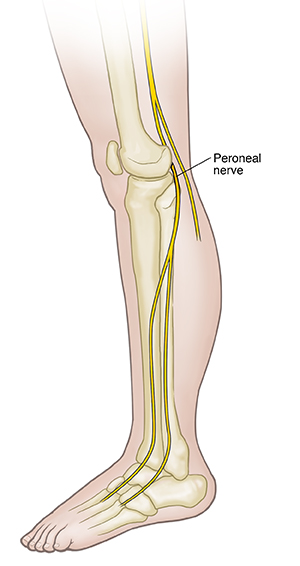Peroneal Nerve Palsy
The peroneal nerve travels down the lower leg and helps lift the foot at the ankle (for instance, when walking). Chronic pressure on the nerve as it passes along the side of the knee is a common cause of peroneal nerve palsy. This causes weakness in the muscles that lift the foot and also causes numbness or tingling on the top of the foot.

This most often occurs in people who are confined to a bed or a wheelchair with pressure on the side of the knee. A knee injury or fracture or crush injury of the lower leg may also cause this problem. The injury is more common in very thin people and in people with diabetes. Crossing your legs may also injure the nerve. Some people who have peripheral neuropathy are more likely to have nerve damage from pressure.
This condition may improve when nerve compression is relieved. Corticosteroid shots (injections) into the area may help to reduce swelling and pressure on the nerve.
Peroneal nerve palsy may cause problems with lifting your foot. The foot may then drag when you walk. This is called foot drop. If you have foot drop, an in-shoe splint may be useful. A cane or walker may help you keep your balance. Talk to your healthcare provider about these options.
Home care
-
Avoid positions that put pressure on the side of the knee.
-
Don't cross your legs for long periods of time.
-
People confined to a bed or wheelchair may need to use padding to protect the knees from pressure. This is especially important if there is a lack of feeling around the knee.
-
If you have reduced feeling in one or both feet, take extra care to protect them:
-
Wear comfortable shoes that fit correctly. Don't wear heels or open-toe shoes.
-
Wash your feet daily with warm water and mild soap.
-
After drying, apply a moisturizing cream or lotion.
-
Wear cotton socks and change them every day.
-
Trim toenails carefully. Don't cut your cuticles.
-
Don't use heating pads or hot water bottles on your feet.
-
Don't put your foot in a hot tub without first checking the temperature with your hand or elbow.
-
Check your feet daily for skin breaks, blisters, swelling, or redness. If you have a reddened area that doesn't go away after 30 minutes or an open sore that doesn't heal, see your healthcare provider.
-
Schedule yearly foot exams.
-
Weakness or loss of feeling in the foot or leg may interfere with your ability to safely drive a car. If you drive, talk to your healthcare provider about this.
Follow-up care
Follow up with your healthcare provider as advised.
When to get medical advice
Call your healthcare provider for any of these:
-
Increasing leg swelling
-
Increasing leg pain, weakness, or numbness
-
Shortness of breath or trouble breathing
-
A reddened area on your leg or foot that doesn't go away after 30 minutes or an open sore that does not heal
Call 911
Call 911 if any of these occur:
Online Medical Reviewer:
Heather M Trevino BSN RNC
Online Medical Reviewer:
Mahammad Juber MD
Online Medical Reviewer:
Marianne Fraser MSN RN
Date Last Reviewed:
11/1/2024
© 2000-2025 The StayWell Company, LLC. All rights reserved. This information is not intended as a substitute for professional medical care. Always follow your healthcare professional's instructions.